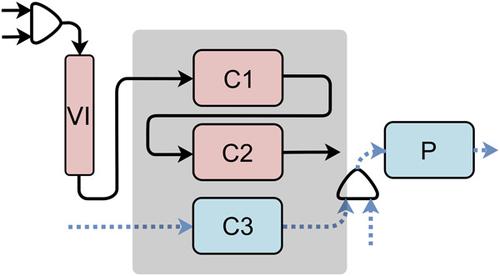当前位置:
X-MOL 学术
›
Biotechnol. Bioeng.
›
论文详情
Our official English website, www.x-mol.net, welcomes your
feedback! (Note: you will need to create a separate account there.)
An integrated continuous downstream process with real‐time control: A case study with periodic countercurrent chromatography and continuous virus inactivation
Biotechnology and Bioengineering ( IF 3.5 ) Pub Date : 2021-01-18 , DOI: 10.1002/bit.27681 Anton Löfgren 1 , Joaquín Gomis-Fons 1, 2 , Niklas Andersson 1 , Bernt Nilsson 1, 2 , Lotta Berghard 3 , Christine Lagerquist Hägglund 3
Biotechnology and Bioengineering ( IF 3.5 ) Pub Date : 2021-01-18 , DOI: 10.1002/bit.27681 Anton Löfgren 1 , Joaquín Gomis-Fons 1, 2 , Niklas Andersson 1 , Bernt Nilsson 1, 2 , Lotta Berghard 3 , Christine Lagerquist Hägglund 3
Affiliation

|
Integrated continuous downstream processes with process analytical technology offer a promising opportunity to reduce production costs and increase process flexibility and adaptability. In this case study, an integrated continuous process was used to purify a recombinant protein on laboratory scale in a two‐system setup that can be used as a general downstream setup offering multiproduct and multipurpose manufacturing capabilities. The process consisted of continuous solvent/detergent virus inactivation followed by periodic countercurrent chromatography in the capture step, and a final chromatographic polishing step. A real‐time controller was implemented to ensure stable operation by adapting the downstream process to external changes. A concentration disturbance was introduced to test the controller. After the disturbance was applied, the product output recovered within 6 h, showing the effectiveness of the controller. In a comparison of the process with and without the controller, the product output per cycle increased by 27%, the resin utilization increased from 71.4% to 87.9%, and the specific buffer consumption was decreased by 21% with the controller, while maintaining a similar yield and purity as in the process without the disturbance. In addition, the integrated continuous process outperformed the batch process, increasing the productivity by 95% and the yield by 28%.
中文翻译:

具有实时控制的集成连续下游工艺:周期性逆流色谱和连续病毒灭活的案例研究
与过程分析技术集成的连续下游过程为降低生产成本和提高过程灵活性和适应性提供了一个有希望的机会。在本案例研究中,采用集成连续工艺在实验室规模的双系统装置中纯化重组蛋白,该装置可用作通用下游装置,提供多产品和多用途制造能力。该过程包括连续溶剂/去污剂病毒灭活,随后是捕获步骤中的周期性逆流色谱,以及最终的色谱抛光步骤。实施了实时控制器,通过使下游过程适应外部变化来确保稳定运行。引入浓度扰动来测试控制器。施加干扰后,产品输出在6小时内恢复,显示控制器的有效性。在使用控制器和不使用控制器的工艺比较中,每个周期的产品产量增加了 27%,树脂利用率从 71.4% 提高到 87.9%,使用控制器的特定缓冲液消耗降低了 21%,同时保持了产率和纯度与没有干扰的过程中相似。此外,集成连续工艺优于间歇工艺,生产率提高了 95%,产率提高了 28%。并且使用控制器将特定缓冲液消耗降低了 21%,同时保持了与无干扰过程中相似的产率和纯度。此外,集成连续工艺优于间歇工艺,生产率提高了 95%,产率提高了 28%。并且使用控制器将特定缓冲液消耗降低了 21%,同时保持了与无干扰过程中相似的产率和纯度。此外,集成连续工艺优于间歇工艺,生产率提高了 95%,产率提高了 28%。
更新日期:2021-03-17
中文翻译:

具有实时控制的集成连续下游工艺:周期性逆流色谱和连续病毒灭活的案例研究
与过程分析技术集成的连续下游过程为降低生产成本和提高过程灵活性和适应性提供了一个有希望的机会。在本案例研究中,采用集成连续工艺在实验室规模的双系统装置中纯化重组蛋白,该装置可用作通用下游装置,提供多产品和多用途制造能力。该过程包括连续溶剂/去污剂病毒灭活,随后是捕获步骤中的周期性逆流色谱,以及最终的色谱抛光步骤。实施了实时控制器,通过使下游过程适应外部变化来确保稳定运行。引入浓度扰动来测试控制器。施加干扰后,产品输出在6小时内恢复,显示控制器的有效性。在使用控制器和不使用控制器的工艺比较中,每个周期的产品产量增加了 27%,树脂利用率从 71.4% 提高到 87.9%,使用控制器的特定缓冲液消耗降低了 21%,同时保持了产率和纯度与没有干扰的过程中相似。此外,集成连续工艺优于间歇工艺,生产率提高了 95%,产率提高了 28%。并且使用控制器将特定缓冲液消耗降低了 21%,同时保持了与无干扰过程中相似的产率和纯度。此外,集成连续工艺优于间歇工艺,生产率提高了 95%,产率提高了 28%。并且使用控制器将特定缓冲液消耗降低了 21%,同时保持了与无干扰过程中相似的产率和纯度。此外,集成连续工艺优于间歇工艺,生产率提高了 95%,产率提高了 28%。










































 京公网安备 11010802027423号
京公网安备 11010802027423号